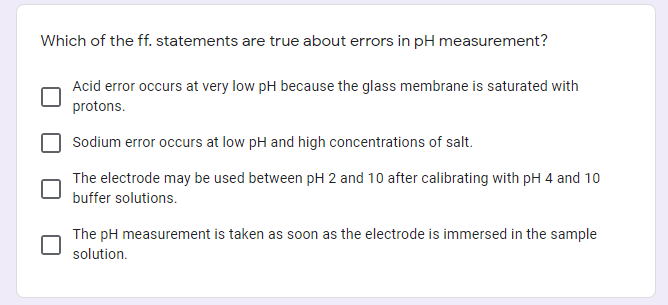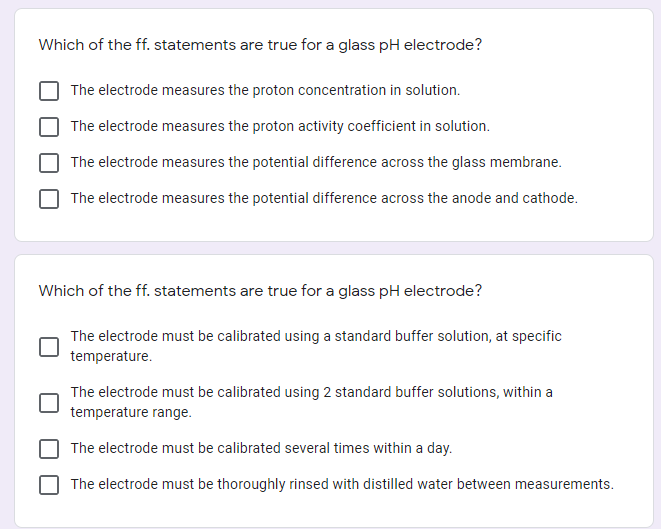Which of the ff. statements are true about errors in pH measurement? Acid error occurs at very low pH because the glass membrane is saturated with protons. Sodium error occurs at low pH and high concentrations of salt. The electrode may be used between pH 2 and 10 after calibrating with pH 4 and 10 buffer solutions. The pH measurement is taken as soon as the electrode is immersed in the sample solution.
Which of the ff. statements are true about errors in pH measurement? Acid error occurs at very low pH because the glass membrane is saturated with protons. Sodium error occurs at low pH and high concentrations of salt. The electrode may be used between pH 2 and 10 after calibrating with pH 4 and 10 buffer solutions. The pH measurement is taken as soon as the electrode is immersed in the sample solution.
Principles of Modern Chemistry
8th Edition
ISBN:9781305079113
Author:David W. Oxtoby, H. Pat Gillis, Laurie J. Butler
Publisher:David W. Oxtoby, H. Pat Gillis, Laurie J. Butler
Chapter17: Electrochemistry
Section: Chapter Questions
Problem 76AP
Related questions
Question
pH Glass Electrode (choose 2 or more correct answer each item)

Transcribed Image Text:Which of the ff. statements are true about errors in pH measurement?
Acid error occurs at very low pH because the glass membrane is saturated with
protons.
Sodium error occurs at low pH and high concentrations of salt.
The electrode may be used between pH 2 and 10 after calibrating with pH 4 and 10
buffer solutions.
The pH measurement is taken as soon as the electrode is immersed in the sample
solution.

Transcribed Image Text:Which of the ff. statements are true for a glass pH electrode?
The electrode measures the proton concentration in solution.
The electrode measures the proton activity coefficient in solution.
The electrode measures the potential difference across the glass membrane.
The electrode measures the potential difference across the anode and cathode.
Which of the ff. statements are true for a glass pH electrode?
The electrode must be calibrated using a standard buffer solution, at specific
temperature.
The electrode must be calibrated using 2 standard buffer solutions, within a
temperature range.
The electrode must be calibrated several times within a day.
The electrode must be thoroughly rinsed with distilled water between measurements.
Expert Solution
This question has been solved!
Explore an expertly crafted, step-by-step solution for a thorough understanding of key concepts.
Step by step
Solved in 2 steps

Knowledge Booster
Learn more about
Need a deep-dive on the concept behind this application? Look no further. Learn more about this topic, chemistry and related others by exploring similar questions and additional content below.Recommended textbooks for you

Principles of Modern Chemistry
Chemistry
ISBN:
9781305079113
Author:
David W. Oxtoby, H. Pat Gillis, Laurie J. Butler
Publisher:
Cengage Learning


Principles of Instrumental Analysis
Chemistry
ISBN:
9781305577213
Author:
Douglas A. Skoog, F. James Holler, Stanley R. Crouch
Publisher:
Cengage Learning

Principles of Modern Chemistry
Chemistry
ISBN:
9781305079113
Author:
David W. Oxtoby, H. Pat Gillis, Laurie J. Butler
Publisher:
Cengage Learning


Principles of Instrumental Analysis
Chemistry
ISBN:
9781305577213
Author:
Douglas A. Skoog, F. James Holler, Stanley R. Crouch
Publisher:
Cengage Learning

Chemical Principles in the Laboratory
Chemistry
ISBN:
9781305264434
Author:
Emil Slowinski, Wayne C. Wolsey, Robert Rossi
Publisher:
Brooks Cole

Chemistry: An Atoms First Approach
Chemistry
ISBN:
9781305079243
Author:
Steven S. Zumdahl, Susan A. Zumdahl
Publisher:
Cengage Learning
